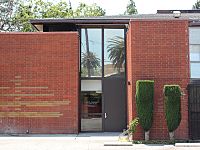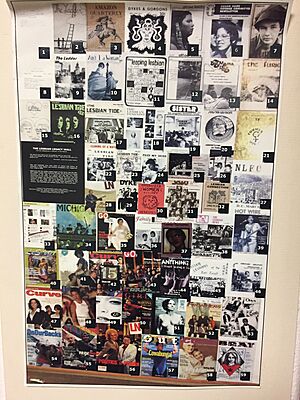- This page was last modified on 17 October 2025, at 10:18. Suggest an edit.
ONE National Gay & Lesbian Archives facts for kids
| ONE National Gay & Lesbian Archives at the University of Southern California Libraries | |
|---|---|
 |
|
| Established | 1952 |
| Location | 909 West Adams Boulevard, Los Angeles, California, 90007 |
| Coordinates | 34°01′52″N 118°16′54″W / 34.03101°N 118.28157°W |
| Other information | |
| Director | Joseph Hawkins |
The ONE National Gay and Lesbian Archives is a special library and museum at the University of Southern California Libraries. It is the oldest organization in the United States for lesbian, gay, bisexual, and transgender (LGBTQ) people. It is also one of the world's largest collections of materials about LGBTQ history.
Located in Los Angeles, California, the ONE Archives holds over two million items. These include books, magazines, films, photos, art, and personal items like clothing and buttons. It also has records from different organizations and personal letters from people. Anyone can visit and use the collections for free.
The organization started in 1952 by publishing ONE Magazine, one of the first magazines for gay people in the country. In 2010, it became part of the University of Southern California (USC) library system.
Contents
What is the Mission of ONE Archives?
The main goal of ONE Archives is to collect, protect, and share historical materials about LGBTQ people. They want to help people learn about and study these important histories.
The History of ONE Archives
The Beginning
The story of ONE Archives starts in 1952 with a group called ONE, Inc. They wanted to create a magazine for gay people, which was a new idea at the time. The first issue of ONE Magazine was published in January 1953. Soon after, they opened the first public office for a gay organization in Downtown Los Angeles.
In 1955, ONE, Inc. began holding conferences where experts and community members could talk about gay and lesbian topics. A year later, they created the ONE Institute to study the history and lives of gay people.
A Big Legal Victory
In 1954, the U.S. government tried to stop ONE Magazine from being sent through the mail, saying it was inappropriate. ONE, Inc. fought this decision in court.
The case, called One, Inc. v. Olesen, went all the way to the Supreme Court of the United States. In 1958, the Supreme Court ruled in favor of ONE, Inc. This was a huge victory. It meant that ONE Magazine and other publications with controversial ideas could be mailed legally.
Growing the Collection
During the 1950s, ONE, Inc. also started a library. A man named Jim Kepner helped collect many books and papers for it.
As the movement for gay rights grew in the 1960s and 1970s, ONE was there to collect important items from that time. By the 1980s, they had many documents that told the story of how the "gay community" was forming.
In 2010, the collection was given to the University of Southern California. This made it an official part of the university's library system, where it is today.
Important Moments for ONE Archives
The history of ONE is full of important firsts for LGBTQ Americans. Here is a timeline of key events:
- 1952: The idea for a magazine for gay people is discussed, and ONE, Inc. is founded.
- 1953: The first issue of ONE Magazine is published. ONE, Inc. opens an office in Los Angeles.
- 1954: The post office tries to stop the magazine from being mailed.
- 1956: The ONE Institute for Homophile Studies (an early term for LGBTQ studies) opens.
- 1958: The Supreme Court rules that ONE Magazine can be sent through the mail.
- 1975: Jim Kepner's personal collection is named the Western Gay Archives.
- 1994: ONE, Inc. merges with another archive to focus completely on preserving LGBTQ history.
- 2000: The archive moves to its current location on West Adams Boulevard, a building provided by USC.
- 2010: The collections officially become part of the USC Libraries.
- 2011: ONE Archives holds a large art exhibition called ... the Archive: Queer Art and Culture in Los Angeles, 1945–1980.
- 2017: ONE Archives works with a major museum to create the exhibition Axis Mundo: Queer Networks in Chicano L.A.
- 2024: ONE Archives organized a major exhibition about science fiction and art in Queer Los Angeles.
What's Inside the Collections?
The collections at ONE Archives focus on LGBTQ history across the United States, especially in the Los Angeles area.
Archival Collections
ONE has over 600 collections of personal papers from activists, artists, and everyday people. They also have records from many different LGBTQ groups. These collections include letters, photos, and other items that tell a story.
Some important collections include records from:
- ACT UP/Los Angeles Records
- The Advocate Records
- Ivy Bottini Papers
- Hal Call Papers
- Jeanne Córdova Papers and Photographs
- DignityUSA Records
- Reed Erickson Papers
- Harry Hay Papers
- Michael Kearns Papers
- Jim Kepner Papers
- Morris Kight Papers and Photograph
- Los Angeles Gay and Lesbian Center Records
- Lambda Literary Foundation Records
- Mattachine Society Project Collection
- ONE, Inc. Records
- Outfest Records
- Twice Blessed Collection, which documents the Jewish LGBTQ experience.
Books and Magazines
The library has over 33,000 books and 13,000 different magazines and newspapers. It has some of the earliest LGBTQ publications ever made, and some might be the only copies left in the world.
Audio and Video
The archive holds thousands of films, videos, and audio recordings. Many of these are preserved with help from the UCLA Film and Television Archive to make sure they last for a long time.
Art, Posters, and Objects
ONE Archives also has a large collection of art, including over 4,000 paintings and drawings. It also collects posters, T-shirts, banners, and other objects like buttons and dolls that are part of LGBTQ history.
Exhibitions and Events
In 2008, ONE opened a gallery space in West Hollywood, California, to show art and history from its collections. The gallery has hosted many exhibitions.
One major exhibition in 2011, part of a city-wide art event, showed art and historical items from the collections. It was the most complete exhibition of materials from ONE Archives ever shown.
The gallery has also shown the work of single artists and materials from other important collections, like the Tom of Finland Foundation.
See also
- Mattachine Society
- LGBT history
- LGBT culture in Los Angeles
- Leather Archives & Museum
- Tom of Finland Foundation
- IHLIA LGBT Heritage in Amsterdam, the Netherlands


